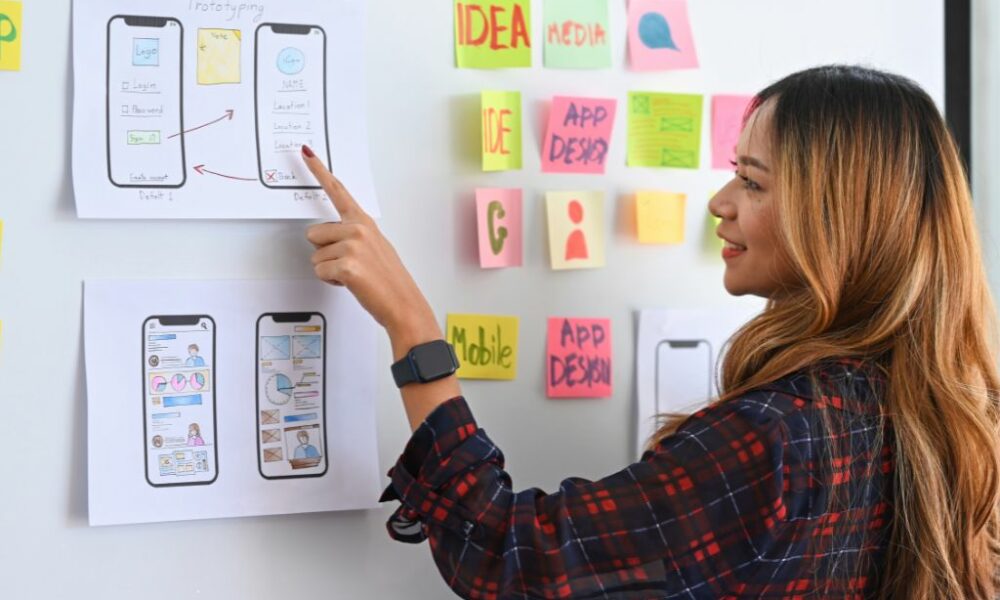Yes, from Pocket to desktop, everywhere it can be accessed with same experience. In today digital world the approximately 60% of internet traffic is originating from mobile devices more than in comparison to any other devices.
This shift towards mobile devices rise the mobile first design philosophy. It is a strategy that help in design and development of smaller screens devices.
This blog will help you to understand the basic principles of the mobile first design and a checklist for app development to meet user expectations.
What is mobile first design?
In simple words mobile first design is an approach to design and develop smaller screens devices for users and then enhancing the user experience for larger desktop screens.
The strategy behind mobile first design is that developers prioritize content and simplify the interface for the small screens to ensure successful mobile experience to users.
Mobile First Design Strategy Optimize the user experience for smaller screens before going to larger screens desktops.
How Mobile-First Design Strategy Came to Be?
The mobile first design strategy came into existence with the rapid increase in mobile internet usage. With more people accessing applications on their smartphones, developers recognize the need to prioritize the mobile experience. For this Developers need a strategy that will help them enhance the user experience in small screens.
Google’s adoption of a mobile first design strategy in 2018 is a notable example of rise of this strategy. Google primarily used mobile versions of websites for indexing and ranking search content. Google uses a strategy that if a website is not optimized for mobile users, it will not perform well in search results.
This shift by Google towards a mobile first design strategy is a turning point in web development and developers now emphasize a mobile first approach to ensure the most important content is easily accessible on smaller screens.
Why Use Mobile First Design Strategy?
Now let us discuss the key principles that underpin why you should use mobile design in the first place:
(1) Content Prioritization: Since the actual position of the mobile screen is limited; A mobile first design strategy emphasizes getting the most important content and features to the screen first.
(2) User Centric Approach: Mobile first design uses icons and dropdown menus to reduce the number of clicks required for the user to access important information.
(3) Touch Friendly Interface: Mobile devices user use touch screen for control; mobile first design prioritizes larger buttons and sufficient spacing to prevent accidental click providing touch friendly interfaces to user.
(4) Responsive Design: A mobile first design strategy focuses on mobile design first but does not exclude other devices. A responsive design remains consistent across different devices while adjusting to layout and screen size.
(5) Performance Optimization: Mobile first design compresses images, minimizes the use of heavy scripts to optimize load times and ensure that app or site runs smoothly on slow mobile networks.
Importance of Mobile First Design Strategy in App Development
Here are important reasons why you should use a mobile first design strategy in app development:
(1) Providing user friendly fast and responsive interface to increase user satisfaction
(2) Mobile friendly websites have been given priority to improve search results in search engines like Google.
(3) As new devices and screen sizes arrive in the future, it continues to evolve to adapt and be better equipped for future devices.
(4) Mobile first design strategy engages the user for longer sessions and leads to higher engagement rates on websites.
App Development Checklist: From Design to Launch
If you want to develop a mobile application it requires lots of careful planning and execution. Here is a comprehensive app development checklist to assist you through the development process:
(A) Pre- Development Phase
- Define Objective and identify the purpose of your app. Determine the target audience, user acquisition, revenue generation source and set clear measurable goals.
- Conduct Market Research to identify your competitors target market and their strategy. Gather insights from user preferences and looks for gaps in market that you can fill.
- Create a Value Proposition and define what makes your app unique. And determine why users would choose your app over others.
- Develop a monetization Strategy and decide how ads, subscription, models and in app purchases your app will generate revenue.
- outline Core features and Functionality of your app needs to deliver its core value proposition to make a potential impact on the user.
- Plan the user Journey from onboarding to task completion and identify checkpoints and interaction that users will have with your app.
(B) Design Phase
- Create wireframes to visualize the app layout and develop a small prototype to test the user experience before full scale development.
- Focus on User Interface (UI) for designing a well-positioned and aesthetically pleasing interface.
- Prioritize user Experience (UX) design using feedback loops to refine design elements based on user input.
- Lightweight interface to optimize display design that loads fast on mobile devices. Use vector graphics, minimize the use of heavy animations and scripts, and compress images to reduce load times.
(C) Development Phase
- Choose appropriate programming languages, frameworks and target platforms likes Ios, Android, ensuring that your technology stack support scalability, security and performance.
- Set up a development environment and implement core features that are essential for app’s functionality.
- Integrate APIs and third-party services like payment gateways, analytics, social media to ensure that integrations are secure and do not compromise the user data.
- Focus on implement robust security to protect the user data and conduct regular security audits and assessments.
(D) Testing Phase
- Conduct testing to test each tool and functions to ensure that they work as properly.
- Perform integration testing to check how different tool of your app interact and usability testing to test your app with real users to gather experience feedback.
- Conduct performance tests to check app performance under different conditions like device type, different network speeds to ensure that your app runs fast under heavy load conditions.
(E) Launch Phase
- Before submission in app store ensure that your app meets defined target.
- Develop a marketing and sales strategy to promote your app between users.
- Plan for Customer Support including FAQs, chat support and email.
(F) Post Launch Phase
- Regularly update your app to fix bugs and improve the performance of app.
- Monitor performance and analytics to track active users, sessions, duration and retention rates.
- update your security tool and stay informed with latest security threats.
Conclusion
In this blog we discussed how mobile first design strategy helps developers to create well-positioned apps that meet user expectations. We discussed about the comprehensive app development checklist to develop an app from pre-development stage to post launch stage. As this technology continues to grow in the future, it will help businesses achieve explosive growth.





